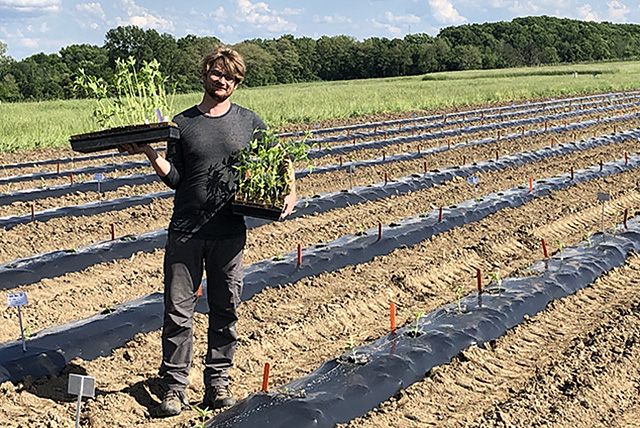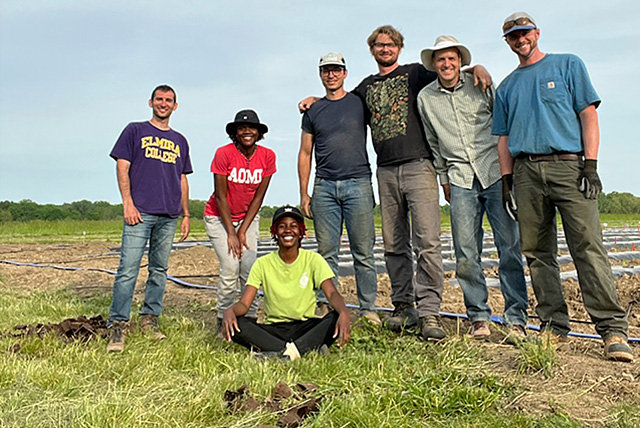
Exploring the Myriad Possibilities of Hemp
 |
Dr. Zachary Stansell is a geneticist, horticulturalist, and curator of the ARS National Plant Germplasm System's Vegetable and Hemp Crop Germplasm Collections at the Plant Genetic Resources Unit (PGRU) genebank. He leads research designed to conserve, maintain, evaluate, and increase hemp genetic resources, and to ensure these genetic resources, or germplasm, are available for long-term research, education, and cultivar development. |
Welcome Dr. Stansell to Under the Microscope.
UM – Where does hemp come from? How long have humans cultivated it, and what have we historically used it for?
ZS – Fascinatingly, there is no broad scientific consensus on where hemp originated. Recent studies conclude that central Asia is the most probable center of origin, although some scholars have also suggested that East Asia and Europe might have been centers of domestication. Archeologists have identified cannabis seeds that date to approximately 8,000 BCE (Before Current Era) in places populated by the Jōmon people in Japan.
Modern evidence suggests that hemp (Cannabis sativa L.) is a single species that has been highly modified by both natural and artificial selection and used for many different applications. Early humans used it for cordage, textiles, paper, seed oil and protein, medicinal, and psychoactive purposes. In the U.S., hemp was a very important crop from colonial times through the 1910s and sporadically thereafter. In the 1930s, the Ford Motor Company operated a biomass conversion plant that processed ethanol from hemp and developed automobile parts constructed from hemp.
UM – What is hemp used for now, and what additional uses are you exploring? What makes it competitive with other products that are currently being used?
ZS – Modern hemp applications include the historic ones (fiber, grain, phytochemicals), but with updated processing techniques. Hemp is also being explored for novel applications including biofuel, sustainable building materials, carbon sequestration, and nanotechnology. It is considered photosynthetically efficient, capable of very high yields, and good at carbon capture. The fiber is also generally considered to be extremely durable and strong for textile and cordage applications. The hurd, or inner woody core of the stalk, is sold as animal bedding, with claims that it's more absorbent, odor-reducing, and produces less dust than straw, woodchips, or sawdust alternatives. There is also a building materials company in Idaho that produces a hemp fiber blend to create insulation material that is a 1:1 replacement for fiberglass insulation. It performs as well as fiberglass while minimizing abrasiveness and other harmful properties.
 Zach Stansell planting germplasm in year one USDA phenotyping trials. (Photo courtesy of Zach Stansell)
Zach Stansell planting germplasm in year one USDA phenotyping trials. (Photo courtesy of Zach Stansell)
Overall, we don't yet know how or whether hemp will augment and/or replace current industrial inputs and outputs. There is no shortage of voices promoting hemp as a 'miracle crop' capable of solving all sorts of problems. It may yet prove to be, but the scientific evidence for such claims has not yet accumulated. There aren't many peer-reviewed studies that back the miracle claims. For hemp to be truly successful, I believe our most pressing priority should be to develop and apply rigorous scientific standards, testing, and breeding.
UM – What characteristics are you exploring or trying to select for in hemp?
ZS – We try to understand how to describe how important traits vary across the wide pool of hemp genetic diversity. This involves collecting and evaluating all sorts of unusual hemp types for many different traits and connecting variation in the traits with their genetic control.
This year, we are assembling approximately 100,000 data points in field trials to evaluate our germplasm collection for plant architectural traits (e.g., is the plant tall and straight or bushy?), flowering time, day-length sensitivity, fiber quality standards (fiber diameter, uniformity, and strength), seed protein and oil content/profile, and secondary metabolites (cannabinoids, terpenes, etc.). We hope to increase the power, scale, and value of our germplasm collection to serve scientists and plant breeders developing high-yielding and locally-adapted hemp varieties.

Hemp seed development, longevity, and dormancy analysis conducted at PGRU. (Photo courtesy of Nicholas Genna)
UM – What is the state of hemp research relative to research on other crops? What other questions or projects are you currently pursuing?
ZS – Due to years of prohibition, hemp research lags behind other crops, but the domestic and international research community has accelerated it to a dizzying pace. I am assembling a suite of resources, such as germplasm, research tools, and information, that enable the international hemp community to better understand the relationship between genetic variation and overall plant performance.
Our genebank conducts research on several key issues related to how best to conserve diverse hemp genetic resources, including long-term seed storage, tissue culture, pollen conservation, and special mapping populations. Dr. Tyler Gordon at our genebank applies a suite of methods to develop breeding lines that harness this pool of genetic diversity; he does this by selecting promising materials suitable for large-scale production across many different growing regions.
UM – What are the challenges of producing seed for breeders and ultimately, the broader market?

Tony Barraco evaluating hemp during the year one PGRU germplasm evaluation. (Photo courtesy of Zach Stansell)
ZS – Maintaining genetic purity and diversity of hemp germplasm is tricky! Hemp is typically diecious (e.g., individual plants have either male or female flowers) and it does not appear to be extremely amenable to inbreeding, so we must maintain a much larger number of individuals than we need for many other crops.
Also, hemp is wind-pollinated, and its pollen is extremely small (20 μm or roughly a third of the diameter of a human hair). Pollen can travel 5 kilometers, so we can't produce pure seed outdoors; we must regenerate it in controlled environment growth chambers, which is rate-limiting. We don't produce seed at a commercial scale, but this is still challenging for many reasons, including pollen control and pest/pathogen management.
UM – How does or will climate change affect the cultivation and breeding of hemp?
ZS – We don't know yet. Generally, we know that climate change drives the distribution and timing of pathogen and pest emergence, increases environmental stresses, and reduces overall plant resiliency. Overly broad statements about the impact of climate change on hemp production specifically are difficult due to a general lack of historical records, a relatively limited understanding of resistances to pests and pathogens, tolerance to extreme weather, and ongoing development of cutting-edge resilient agronomic production strategies.
Hemp is considered to use water efficiently and to be relatively tolerant of heat, so it might fare better than other crops under many climate change scenarios. I think it's a fair assumption that hemp breeders, pathologists, and agronomists will be kept quite busy in the decades to come.

The USDA-ARS PGRU hemp team. The team had just finished planting 2,412 plants in the first germplasm evaluation trial. The team included Zach Stansell (third from right) and several collaborators (Tony Barraco, Zaria Smith, Ashya Reid, Nick Genna, Tyler Gordon, and Peter Herzeelle) (Photo courtesy of Zach Stansell)
UM – How will hemp cultivation practices (the cultural conditions) vary, depending on how the crop will be used?
ZS – The overwhelming number of uses for hemp translates into many production systems and techniques. Hemp can be grown indoors and outdoors. Indoor production tends to be highly automated and dependent on a suite of emerging technologies. Outdoor fiber production tends to be planted in very high density to encourage tall, thin, non-branching plants. Some growers are trying dual production, where the plants are harvested for both grain and fiber. Robotics, unoccupied aerial vehicles (UAVs or drones), machine learning, and computer vision will likely be important tools for hemp production, especially for weed control and precision management.
Related Information
- Overview: ARS Collaborative Hemp Research
- Recent webinar series on hemp science and research co-hosted by ARS and Cornell University.
- Article: ARS Scientists Provide Insight into an Age-Old Crop.
